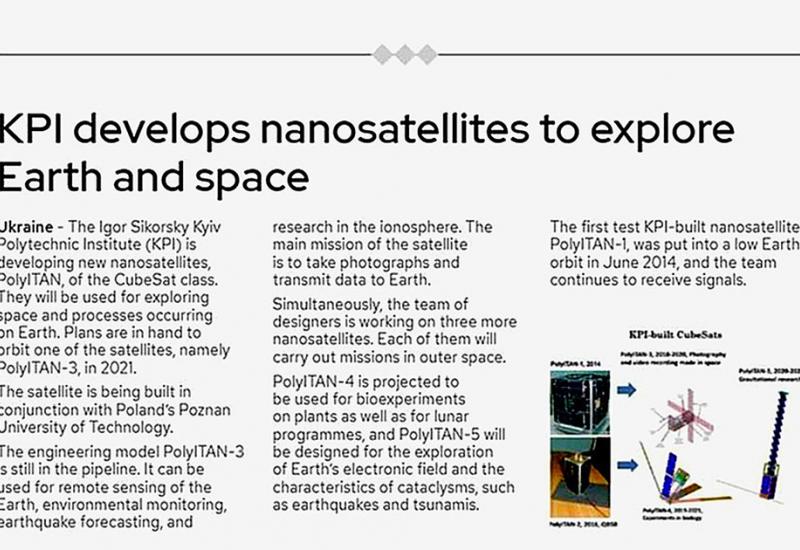In May 2021, the “QS Global Education News” (QS GEN) magazine, the compiler of university rankings “Quacquarelli Symonds”, published a new article about Igor Sikorsky Kyiv Polytechnic Institute. As you remember, the first article told about the contribution of Igor Sikorsky Kyiv Polytechnic Institute to the Hayabusa-2 space probe mission and was published in March this year. This one also gives information on researchers and students of our University participating in space programs. To be precise, the article is about nanosatellites already created and those being developed at our University.
The article is called “KPI develops nanosatellites to explore Earth and space”. It is clear from the title that the article gives brief information about a spacecraft. It may be of interest to a large specialized international audience. QS GEN has numerous readers because the QS university rating covers more than 1,600 universities around the world. However, we think that the “KP” newspaper readers may want to know this information, so we offer this material in Ukrainian translation.
Igor Sikorsky Kyiv Polytechnic Institute is designing new nanosatellites of the PolyITAN series of CubeSat standards. They will study space and sense the Earth. One of the satellites - PolyITAN-3 - will be launched for performing tasks in the Earth orbit in 2021.
The satellite is being developed in conjunction with the Poznan University of Technology.
At this time, the engineering model PolyITAN-3 is still in preparation. Such satellites allow remote sensing of the Earth, environmental monitoring, earthquake forecasting, and ionosphere research. The main task of the satellite is to shoot and transfer images to the earth station.
The third PolyITAN will transfer images of the Earth: it will photograph and send this data for research. It features an additional imaging unit and solar panels, which have the form of 4 wings. Each wing consists of two modules of six elements. Thus, specific wings increase the satellite's power supply.
This feature is associated with new challenges in the thermal control system and the power supply of the satellite. Solar panels have the form of 4 wings. Each wing consists of two modules of six elements. The modules are connected in the wing by the mechanism of opening and connected in series. In addition, a high-speed radio link module is used.
Besides PolyITAN-3, the Igor Sikorsky Kyiv Polytechnic Institute team is working on three subsequent nanosatellites. Each of them will fulfill its mission in outer space.
For example, PolyITAN-4 will get engaged in bio experiments with plants and lunar programs. The PolyITAN-5 aims to study the Earth's electronic field and the characteristics of terrestrial cataclysms, such as earthquakes and tsunamis.
We want to remind you that the first testing nanosatellite launched into orbit in June 2014. Today, nanosatellite is operating in low-Earth Sun-synchronous orbit. During these moments, the team gets information about the functioning of the nanosatellite subsystems and all necessary information from them. The second satellite, PolyITAN-2-SAU, is launched into the near-Earth orbit in 2017. It was created as part of the scientific space network of the QB50 project intended for studying the thermosphere.

